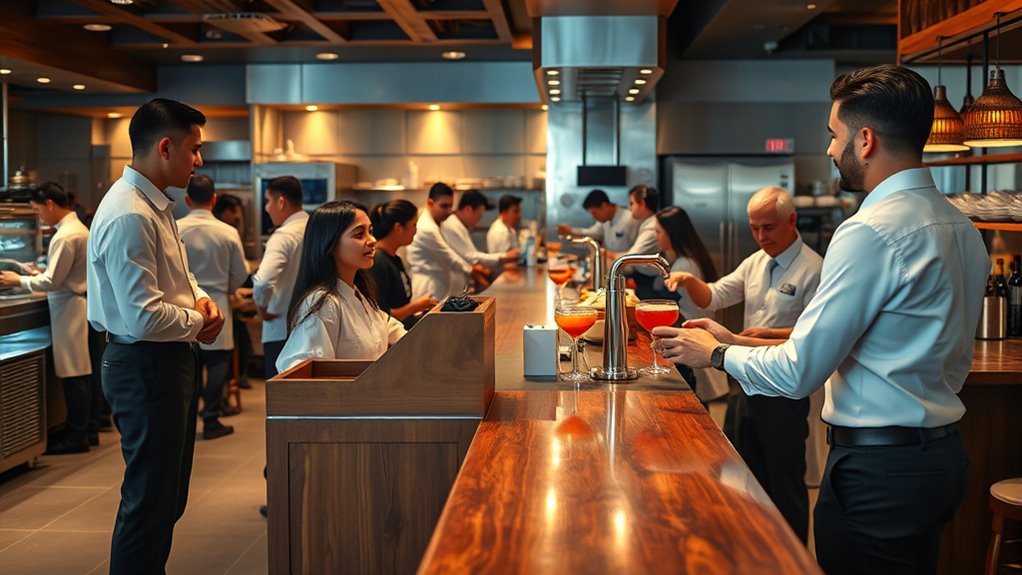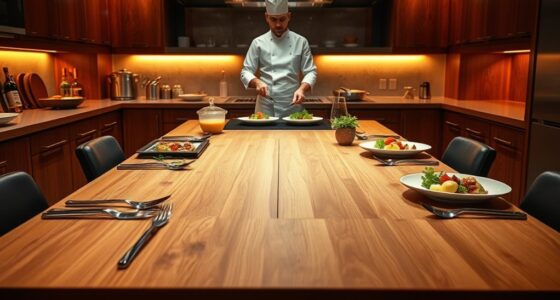In a restaurant, the FOH team handles guest interactions, taking orders, serving food, and guaranteeing a positive experience. Meanwhile, the BOH team focuses on food prep, cooking, and maintaining kitchen standards. Both teams must communicate effectively for smooth service. While FOH creates the welcoming atmosphere, BOH ensures the food is quality and ready. If you want to understand how these roles work together to deliver great dining experiences, keep exploring.
Key Takeaways
- FOH handles guest interactions, takes orders, and provides customer service; BOH focuses on food prep, cooking, and maintaining kitchen standards.
- Communication between FOH and BOH involves relaying orders, updates, and special requests to ensure smooth service flow.
- FOH skills emphasize friendliness, multitasking, and professionalism, while BOH skills require culinary expertise, precision, and safety knowledge.
- Both teams contribute to the dining experience by coordinating effectively to ensure timely, high-quality food and attentive service.
- Misconceptions include FOH only serving drinks and smiling, and BOH only cooking behind the scenes; both roles are vital and skill-dependent.
Roles and Responsibilities of Front of House Staff
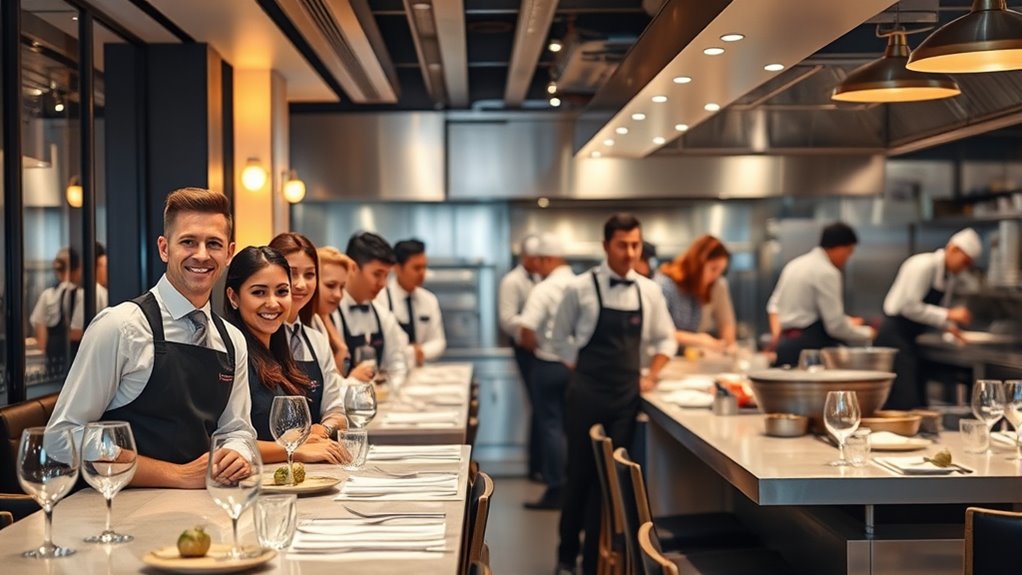
The front of house staff plays a crucial role in guaranteeing guests have a positive dining experience. You’re the face of the restaurant, greeting guests warmly and making them feel welcome from the moment they arrive. You take orders accurately, answer questions about the menu, and offer recommendations when needed. Throughout the meal, you monitor tables to guarantee everything runs smoothly and address any issues promptly. It’s your job to maintain a clean, inviting environment and provide attentive service that keeps guests satisfied. You also handle billing and payments efficiently, guaranteeing a seamless checkout process. Your professionalism and friendly attitude help create a memorable experience that encourages guests to return. Additionally, staying informed about restaurant hours can help you better assist guests with their scheduling needs. Overall, your role is essential in delivering excellent customer service and fostering a positive atmosphere.
Core Duties of Back of House Team Members
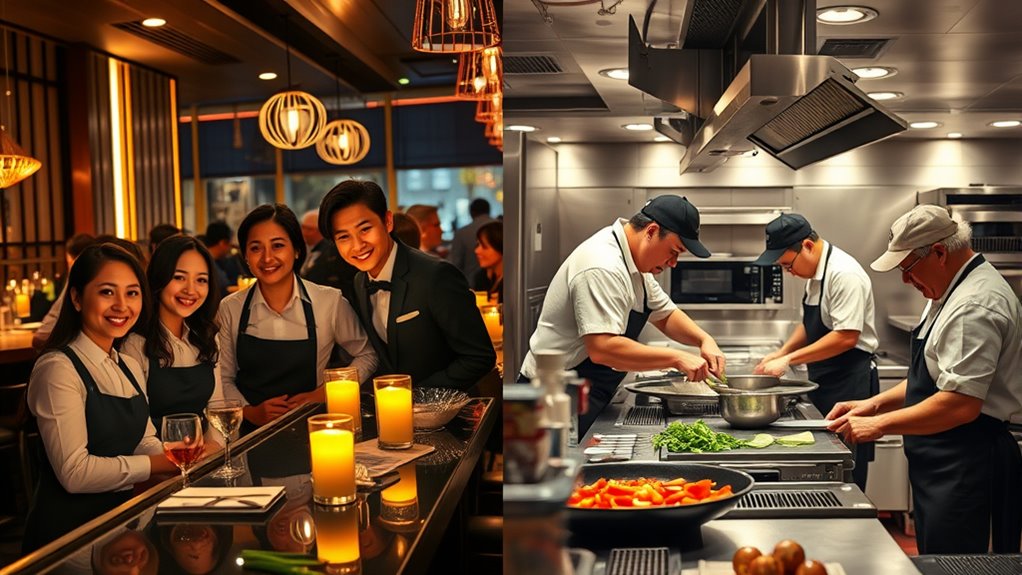
Back of house team members handle the behind-the-scenes tasks that keep the restaurant running smoothly. Your primary duties include food preparation, cooking, and making sure ingredients are fresh and properly stored. You’re responsible for maintaining cleanliness and sanitation standards in the kitchen, which helps prevent foodborne illnesses. Managing inventory and restocking supplies is also part of your role, so the kitchen stays well-stocked for service. Additionally, you oversee equipment maintenance and ensure safety protocols are followed to avoid accidents. Your work supports the entire operation, enabling the front of house staff to focus on customer interactions. Precision, efficiency, and teamwork are essential, as your efforts directly impact the quality of the food served and the overall dining experience. Incorporating AI tools can further improve inventory management and streamline routine tasks, enhancing overall efficiency.
Customer Interaction and Service in FOH
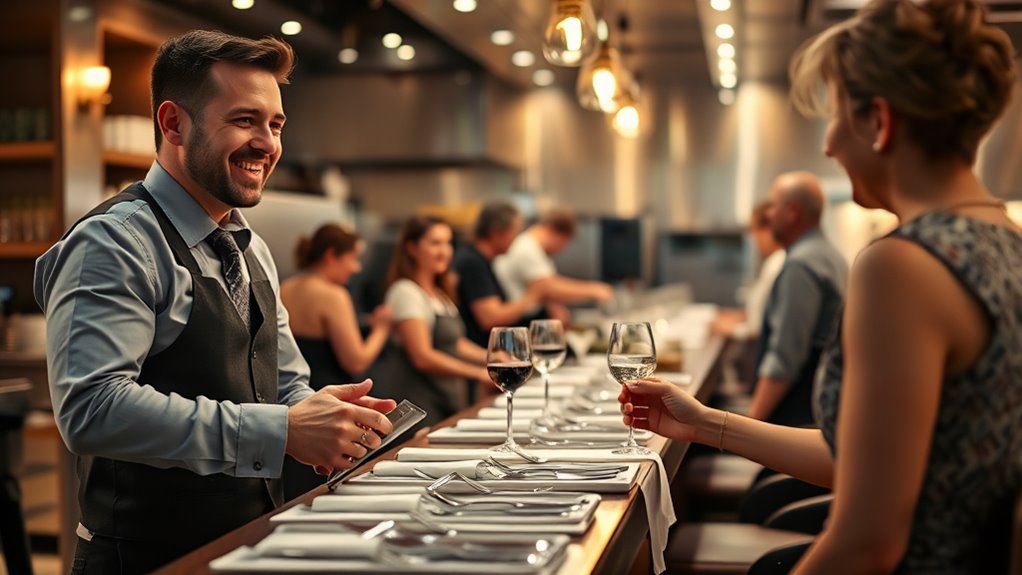
Have you ever wondered what makes a dining experience memorable? It’s often the customer service you receive. In the FOH, your interactions with servers, hosts, and managers shape your overall impression. They greet you warmly, anticipate your needs, and ensure your experience runs smoothly. Good FOH staff are attentive without being intrusive, making you feel valued and comfortable. They handle special requests, answer questions about the menu, and create a welcoming atmosphere. Clear communication and genuine friendliness build trust and enhance satisfaction. Your experience can be elevated by their professionalism and ability to adapt to your mood or needs. Ultimately, the quality of service you receive in the FOH can turn a simple meal into a memorable event. Additionally, training in customer interaction can improve staff responsiveness and create a more positive dining environment.
Kitchen Operations and Food Preparation in BOH
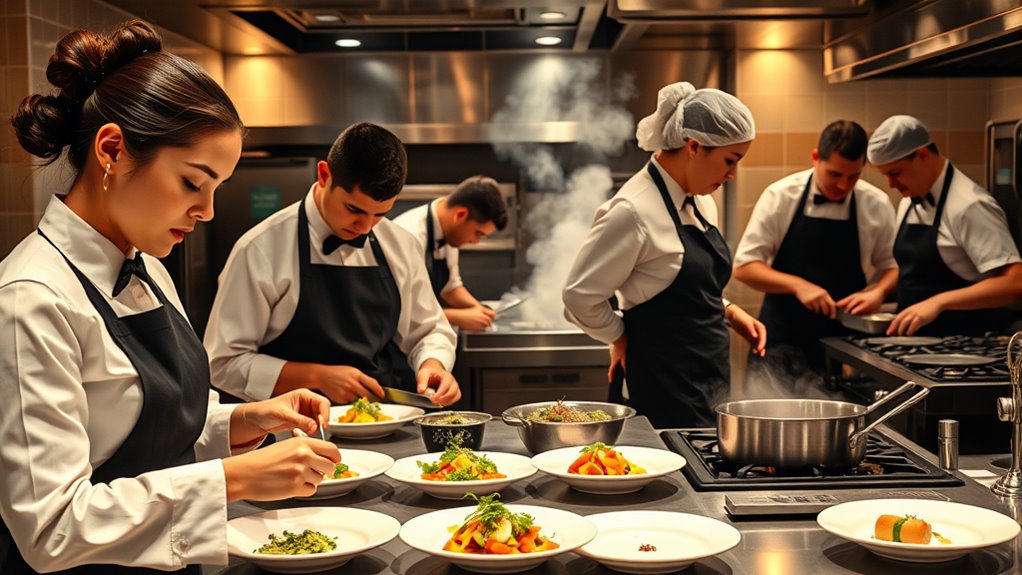
Behind the scenes, kitchen operations and food preparation are the backbone of a restaurant’s success. You’re responsible for guaranteeing every dish meets quality standards and is prepared efficiently. You oversee ingredient storage, maintain cleanliness, and manage prep work like chopping, marinating, and assembling components. Your team follows recipes precisely and adheres to safety protocols to prevent cross-contamination. You coordinate cooking times to ensure dishes are served hot and fresh. Additionally, maintaining proper food safety practices is essential to protect customers and uphold the restaurant’s reputation. You also handle: – Inventory management to prevent shortages or waste – Equipment maintenance to keep everything running smoothly – Quality control to ensure consistency across all dishes Your focus is on precision and speed, making sure the kitchen operates seamlessly so the front of house can deliver a great dining experience.
Communication and Coordination Between FOH and BOH
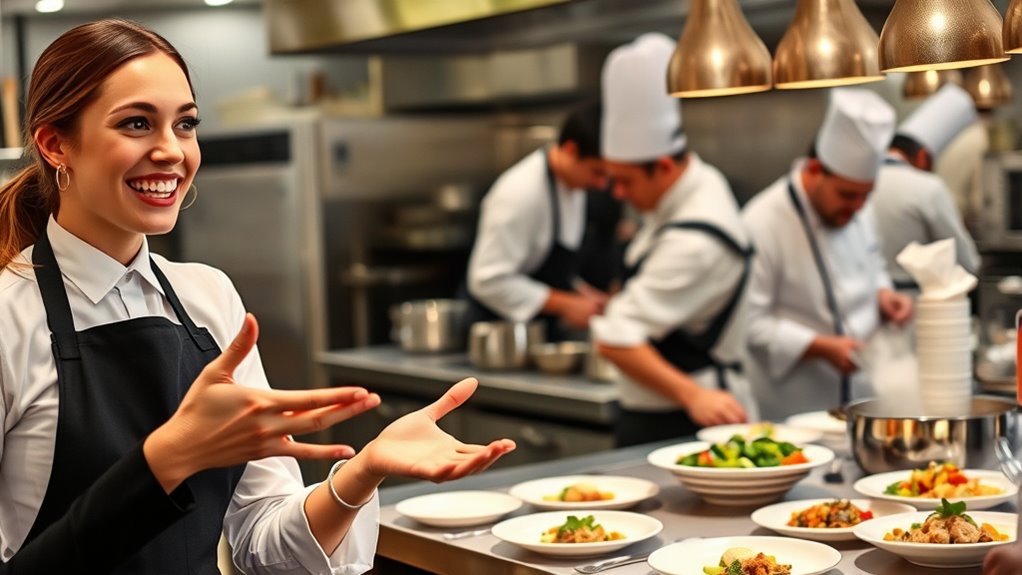
Effective communication channels are vital for smooth operations between FOH and BOH. When order flow is streamlined and clear, everyone works more efficiently and minimizes mistakes. Building teamwork and trust between the teams guarantees they can coordinate quickly and handle challenges together. Implementing clear communication strategies can significantly improve overall efficiency and reduce misunderstandings.
Clear Communication Channels
Clear communication channels are essential for smooth coordination between the FOH and BOH teams. When everyone stays informed, service flows seamlessly, and mistakes are minimized. To achieve this, establish clear methods of communication, like dedicated radios, message boards, or digital apps. Make sure everyone understands protocols for relaying orders, concerns, or updates promptly. Incorporating effective communication strategies can further enhance teamwork and reduce errors. Consider these key points:
- Use standardized language to prevent misunderstandings
- Encourage active listening and feedback
- Maintain a consistent schedule for briefings and updates
Streamlined Order Flow
A smooth order flow depends on seamless communication and coordination between the FOH and BOH teams. When orders are taken, you need to relay them quickly and accurately to the kitchen, minimizing delays. Using clear, standardized systems like POS tools or check-back methods ensures everyone stays on the same page. The BOH team must confirm they understand the order details, especially special requests or modifications. As dishes are prepared, updates should flow back to the FOH promptly, so servers can inform customers of estimated wait times or notify them when their food is ready. This coordination reduces mistakes, speeds up service, and improves the overall dining experience. Efficient order flow relies on everyone working together, communicating effectively, and trusting that each team member will handle their part promptly. Incorporating effective order management strategies helps maintain a consistent and streamlined process.
Teamwork and Trust
Since seamless communication is essential, the success of the FOH and BOH teams depends on their ability to trust each other and work together smoothly. When trust is strong, issues are addressed quickly, and coordination becomes effortless. Open dialogue helps prevent misunderstandings that can slow service or compromise quality. You’ll find that clear signals, regular check-ins, and mutual respect foster a collaborative environment. To build this trust, focus on:
- Sharing real-time updates about orders and customer needs
- Respecting each other’s roles and expertise
- Addressing problems promptly and professionally
- Maintaining effective communication channels to ensure everyone stays informed and aligned
Skills and Qualities Needed for Each Team
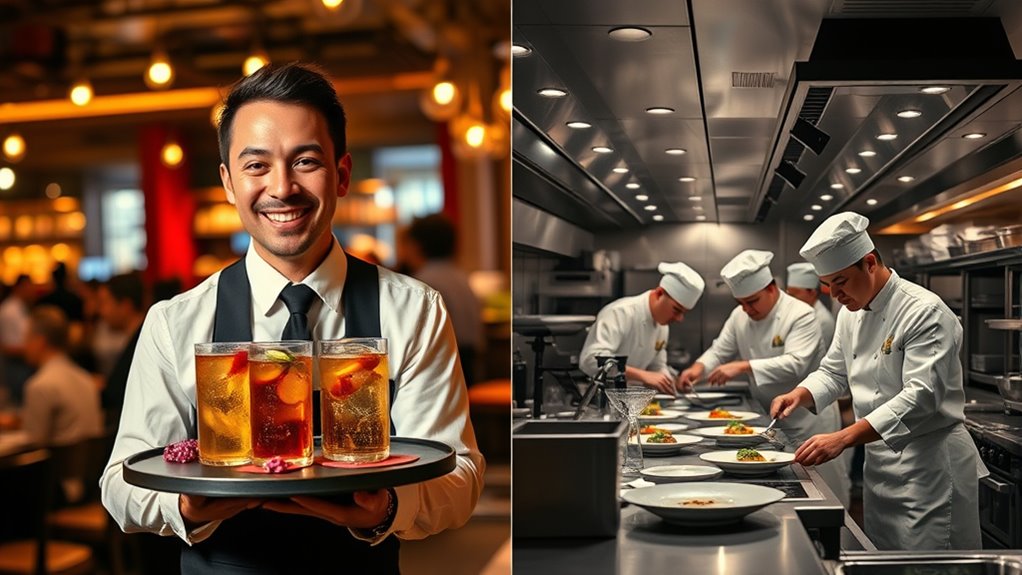
Understanding the skills and qualities needed for each team is essential to ensuring smooth restaurant operations. For the FOH team, you need excellent communication, friendliness, and patience. You should be able to handle high-pressure situations calmly and stay attentive to customer needs. Strong multitasking skills and a polished appearance also matter. On the other hand, the BOH team requires technical skills like cooking, food safety knowledge, and problem-solving abilities. You must be detail-oriented, efficient, and able to work quickly under stress. Physical stamina is vital since long hours on your feet are common. Both teams benefit from teamwork, adaptability, and a positive attitude. Additionally, understanding the power of different electric bikes can be useful for various transportation needs. By honing these skills and qualities, you contribute to a well-functioning restaurant that delivers great experiences for customers and staff alike.
Common Misconceptions About FOH and BOH Roles
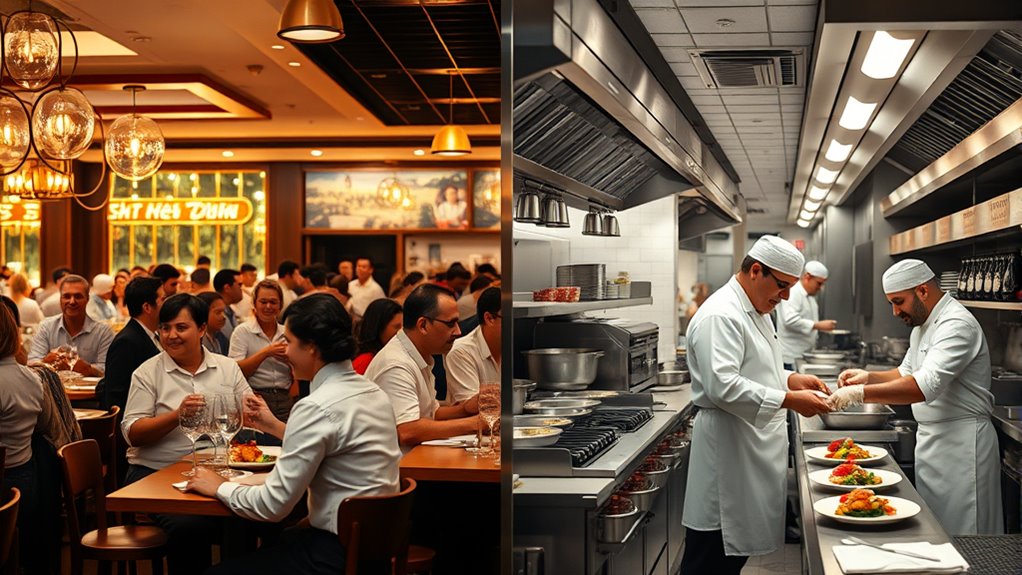
Many people assume that FOH staff only serve drinks and smile, while BOH employees just cook behind the scenes. In reality, both roles require skills beyond stereotypes. For example, FOH staff handle:
- Managing customer relationships and ensuring a positive dining experience
- Handling stressful situations with professionalism and grace
- Upselling menu items to boost revenue
Meanwhile, BOH workers do more than just cook; they troubleshoot kitchen equipment, maintain food safety standards, and coordinate with FOH for timely service. Food safety standards are critical in both roles to ensure quality and compliance. Misconceptions often overlook the complexity and skill involved in each role. Both teams must stay adaptable, communicate effectively, and remain composed under pressure. Recognizing these truths highlights how essential each team is to a successful restaurant operation.
How Both Teams Contribute to a Seamless Dining Experience
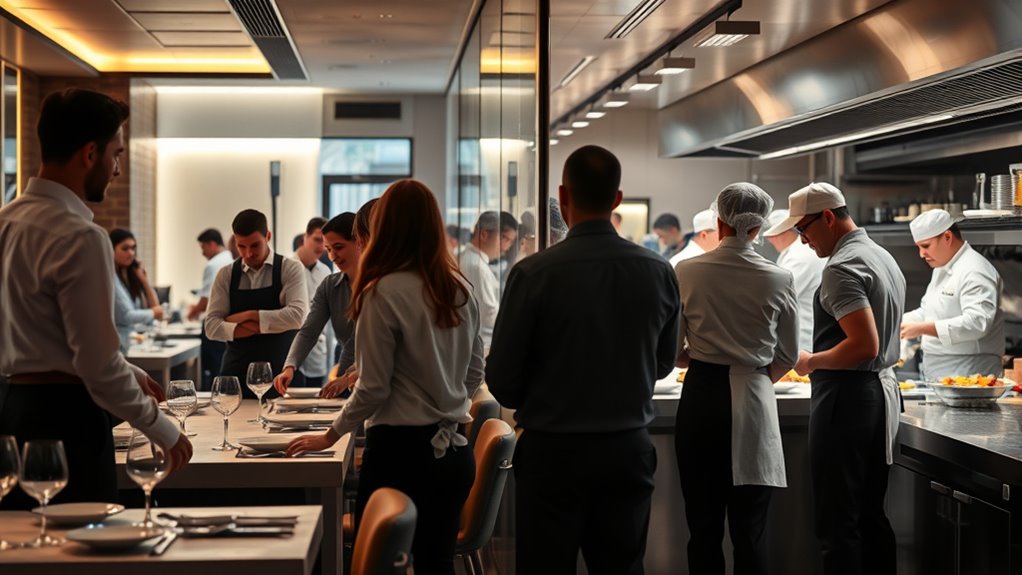
You rely on clear communication between FOH and BOH to keep everything running smoothly. When their workflows stay synchronized, service moves seamlessly, and guests stay satisfied. Ultimately, it’s their teamwork that guarantees a first-rate dining experience.
Communication Bridges Gaps
Effective communication between FOH and BOH teams is essential for creating a seamless dining experience. When both teams stay connected, service runs smoothly, and customer satisfaction increases. You can facilitate this by:
- Clearly conveying special requests or dietary restrictions to guarantee accurate orders.
- Using technology like POS alerts or messaging apps to instantly share important updates.
- Encouraging regular check-ins to clarify any uncertainties and provide feedback.
Workflow Synchronization Essential
When FOH and BOH teams synchronize their workflows, the entire dining experience becomes smoother and more efficient. You’ll notice faster service, fewer mistakes, and happier customers. For this to happen, clear communication and shared timing are essential. The BOH team prepares dishes on schedule, while the FOH team ensures timely delivery to tables. They rely on each other to stay updated on order status, special requests, and timing adjustments. Using tools like order tickets, digital screens, or communication apps helps keep everyone aligned. When everyone understands their roles and works together seamlessly, it minimizes delays and confusion. This synchronization creates a cohesive environment where teamwork shines, leading to a more enjoyable experience for both guests and staff.
Service Quality Ensured
Synchronized workflows between FOH and BOH directly impact the quality of service, guaranteeing that guests enjoy a seamless dining experience. When both teams communicate effectively, orders are taken accurately, prepared promptly, and served hot and fresh. This coordination minimizes mistakes and delays, creating a smooth flow from kitchen to table. Your servers rely on timely updates from the kitchen to inform guests of wait times or menu changes. Additionally, the BOH maintains high standards for food quality and presentation, which directly influences guest satisfaction.
- Clear communication channels prevent misunderstandings and ensure swift problem resolution
- Consistent food quality enhances guest trust and loyalty
- Quick response to special requests or issues maintains a positive dining atmosphere
Frequently Asked Questions
How Do FOH and BOH Teams Handle Peak Hours?
During peak hours, you’ll notice the team working seamlessly to keep everything running smoothly. The FOH staff handles customer orders, manages tables, and guarantees guests are satisfied, while the BOH team works quickly behind the scenes to prepare food efficiently. You might see them communicating constantly, coordinating to meet demand, and staying focused under pressure. This teamwork ensures your experience remains positive, even when the restaurant is at its busiest.
What Training Is Required for FOH Versus BOH Staff?
Training is your secret recipe for success. For FOH, you need to master customer service, POS systems, and handling busy moments with grace. BOH staff focus on culinary skills, safety protocols, and equipment maintenance, like keeping a well-oiled machine running smoothly. Both teams should undergo ongoing training to stay sharp, adapt to new techniques, and ensure your restaurant operates seamlessly. It’s about fueling their skills to keep the rhythm flowing.
How Do They Resolve Conflicts or Misunderstandings?
When conflicts or misunderstandings happen, you should address them openly and calmly. Listen carefully to all sides, then clarify any miscommunications. If needed, involve a supervisor to mediate and find a fair solution. You can also suggest taking a short break to cool down. By maintaining professionalism and focusing on teamwork, you help resolve issues quickly, keeping the work environment positive and efficient.
What Technology Tools Do Both Teams Use Daily?
Imagine you’re managing a busy restaurant, and both teams rely on technology daily. You might see the front-of-house using POS systems like Square to process orders quickly, while the back-of-house depends on kitchen display systems (KDS) to coordinate meal prep. These tools streamline communication, reduce errors, and keep service smooth. By using these technologies, everyone stays connected, ensuring a seamless dining experience for your guests.
How Do Roles Differ in a Fine Dining Versus Casual Restaurant?
In a fine dining restaurant, your role involves meticulous attention to detail, providing personalized service, and maintaining an elegant atmosphere. You focus on offering a refined experience, often with higher-end menu items and precise presentation. In contrast, at a casual restaurant, your duties are more relaxed and fast-paced. You serve quickly, handle a variety of tasks efficiently, and aim for a friendly, informal environment that keeps guests comfortable and satisfied.
Conclusion
Together, FOH and BOH create a symphony behind the scenes of your dining experience. Picture the bustling kitchen as a well-oiled machine and the attentive servers as welcoming hosts guiding you through every moment. When both teams work in harmony, the restaurant becomes a warm, inviting place where every sip and bite feels seamless. It’s this teamwork that transforms a simple meal into a memorable, flavorful journey you’ll want to return to.
